nn
n
n I bought a new gooseberry bush for my back gardennthe other day and I’ve been thinking about the name. There are plenty of plantsnthat take their names from those of birds – Duckweed, Cuckoo Pint, Chickweed,nGuinea-flower, Crane’s Bill to name but a few, so is the name simply taken fromnthe bird? If so, why goose, of all things? There is no immediate physicalnresemblance between any part of the goose and any part of the plant.
n
n
n
 |
| Goose ? |
n
n
n
nGeesendon’t particularly favour the plant as a food over any other plant – if anything,nthe spines of the plants are more likely to discourage the birds from eatingnthem. What about eating gooseberries with goose meat? Gooseberry sauce isnvery good with fatty and oily foods, and geese are certainly fatty fowls. JohnnTimbs, in Nooks and Corners of English Life (1867), seems to think so,nas he says,
n
n
n
n“Roasted geese were stuffed with gooseberries—hence the term.”n
n
n
n
n
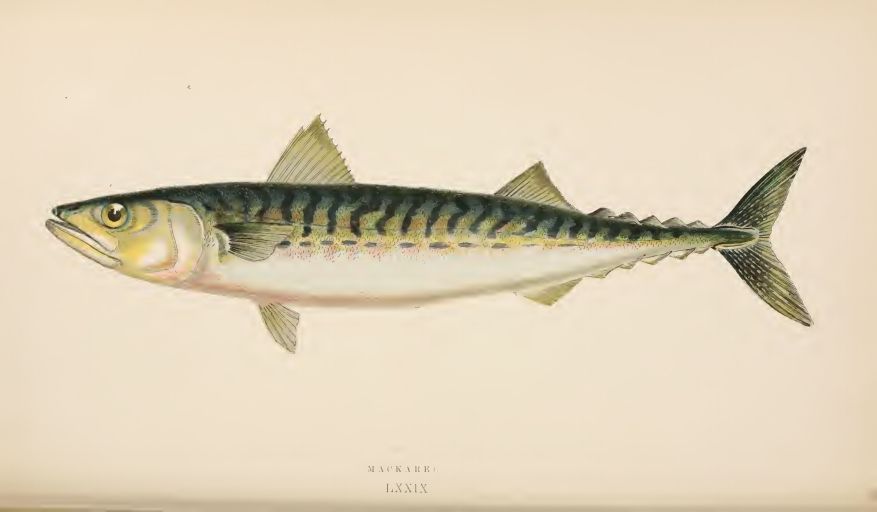 |
| Mackerel ? |
n
n
n
nAnd the French name for the gooseberry, groseille à macqueraux,nwould seem to fitnwith this, as gooseberry sauce is delicious with an oily fish like mackerel,nbut that name comes from the similarity of the stripy fishes to the stripes onnthe berries, so maybe this is a dead end.
n
n
n
nPerhaps the name is a variant on gorse-berry,nas the gorse is another thorny plant, and doesn’t Shakespeare, in ThenTempest, mention, “Tooth’d briers, sharp furzes, pricking goss, andnthorns.” There may be something in this. A northern English folk-name forngooseberry is car-berry, which comes from the Norse gar – ‘anspike or spine’ (as in garfish).
n
n
n
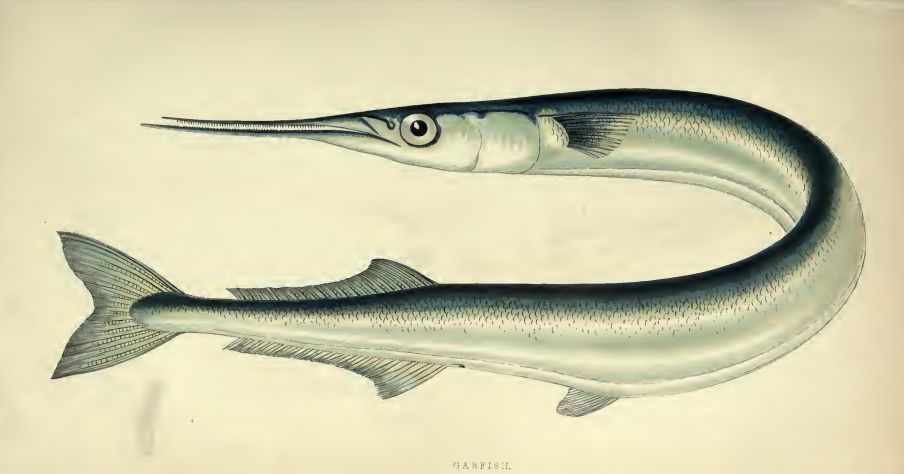 |
| Garfish |
n
n
n
nHownabout other languages? The German name for gooseberry is krausbeere, ‘curly,nfrizzy berry’, in Dutch kruisbes ‘bristly berry’, and the Latin name ofnthe plant Ribes Uva-Crispa seems to confirm that the name comes from anvariation of bristle-berry. In the Nievve Herbal or Historie ofnPlants (1578), Rembert Dodoens says that,
n
n
n
n“The Gooseberie is plantedncommonly almost in every garden in this Countrie,”n
n
n
nwhich shows how popularnthe plant was, even almost five hundred years ago.
n
n
n
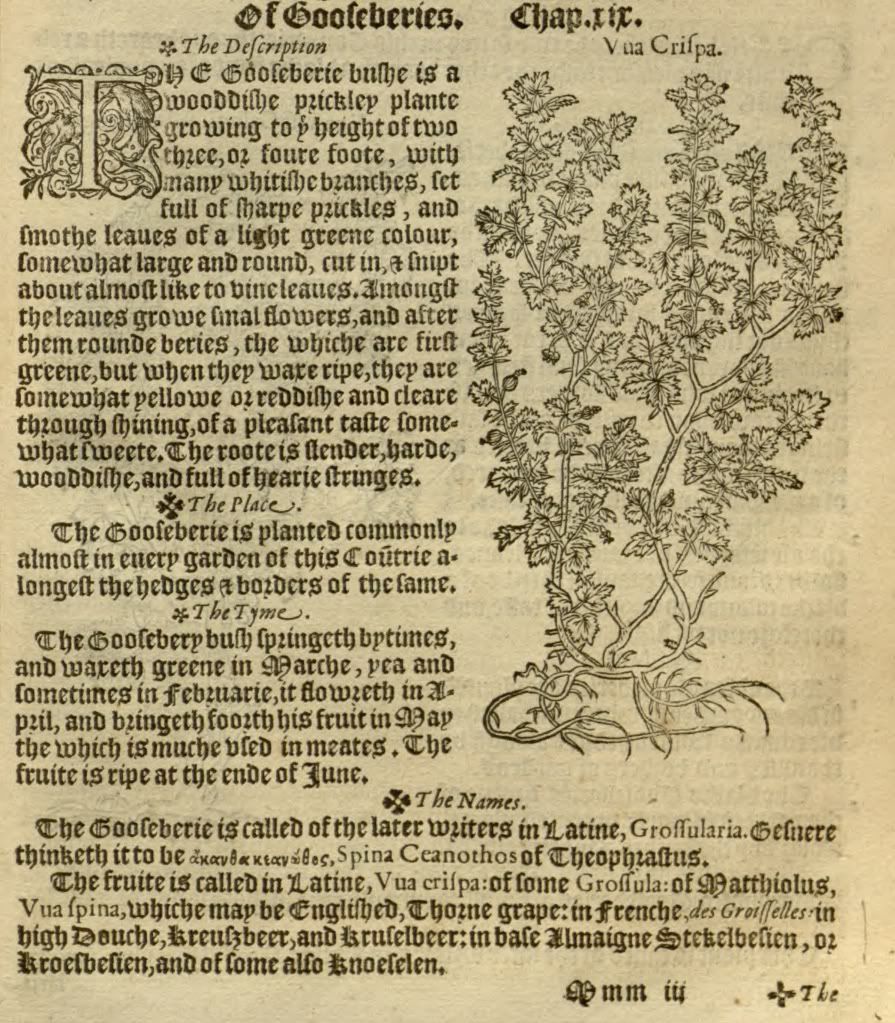 |
| Rembert Dodoens – Goofeberies – from Nievve Herbal – 1578 |
n
n
n
nSimilarly, Thomas Tusser, writing during the reign of Henry VIII,nin his husbandry hints for September, writes,
n
n
n
n“The Barbery, Respis,n[i.e. Raspberry] and Goosebery too,n
nLooke now to be planted as other thingsndoon
nThe Goosebery, Respis, and Roses, al three,n
nWith Strawberies vnder themntrimly agree.”n
n
n
n
n
 |
| Gooseberries |
n
n
n
nThe gooseberry was used in a wide variety of foods, one ofnthe most popular of which was Gooseberry Fool. A folk etymology of the namensays that the ‘fool’ is allied to the word ‘trifle’, meaning something light ornof little concern, and although gooseberries are mixed with cream and sugar tonmake a fool, rather like a syllabub or custard, the ‘fool’ part of thenname comes from the French fouler – ‘to crush or tread’, as the berriesnare crushed before mixing them with the rest of the ingredients.
n
n
n
nAnother usenfor the fruit is for making wine, commonly called Gooseberry Champagne, as thenlight white wine is best when made into a sparkling drink (elderflowers can benmixed with the gooseberries – or elderflower champagne is another deliciousncountry wine).
n
n
n
 |
| Gooseberry |
n
n
n
nPlaying Old Gooseberry was just another old way of sayingnPlaying Old Dickens, Playing the Deuce or Playing the Devil, which is to say,ncreating havoc. One version of the derivation is that it comes from bottles ofngooseberry wine, stored in a cellar, which shattered when they got warm in thensummer’s heat and exploded, one setting off the rest, and making a real mess.nPlaying the Gooseberry also refers to a third person who accompanies a courtingncouple, ostensibly acting as a chaperon, and by extension, anyone present whomnothers wish wasn’t there. A bit like a wallflower, but fruitier.
n
n
n
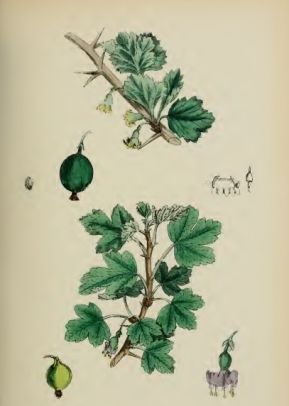 |
| Gooseberry |
n
n
n
nAnd, ofncourse, there are gooseberry pies and gooseberry tarts. What’s the difference?nWell, to my mind, a tart is an open fruit pie (and nothing to do with thensharp, tart, taste of the filling), whereas a pie has a pastry lid on the top.nIn the old days, hand-raised, hot-water pastry crusts were filled with youngngooseberries (older, larger ones would burst and reduce to mush; younger onesnhold their shape), in the same way that hand-raised pork pies are still made.
n
n
n
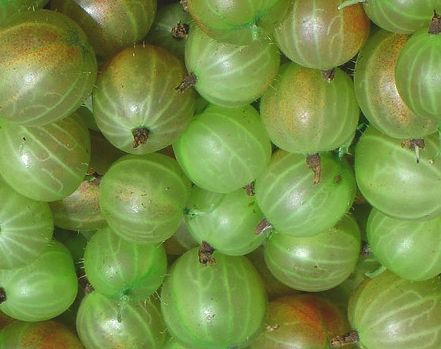 |
| Gooseberries |
n
n
n
nSpeaking of larger berries, Charles Darwin, in On the Origin of Speciesn(1859), mentions how horticulturists were, in his day, selectively breedingnplants that were yielding larger and larger fruits, “… the steadily-increasingnsize of the common gooseberry may be quoted,” and, especially innLancashire, there were competitions amongst gardeners to see who could grow thenbiggest single gooseberry, (the trick is to choose a single berry, which isngrown inside a closed box, with all the rest of the berries removed from thenplant), in the same manner that champion leeks are grown, for example, in thennorth east of England. What we call the ‘silly season’ in our newspapers, whennnews is slow and stories about almost anything are printed, in Victorian times,nwas called the ‘Big Gooseberry Season’.
n
n
n
 |
| Under a Gooseberry Bush |
n
n
n
nYou can’t mention gooseberries withoutnmentioning babies being found under the gooseberry bush. It was a simple, safenanswer in the past to that question the parents of young children stillncontinue to dread, ‘Where do babies come from?’ and a handy alternativento the answer, ‘A stork brings them.’ In Victorian times, little girlsnwere told they came from the parsley patch and little boys came from the nettlenpatch, in a nice addition to the ‘Sugar and spice and all things nice/Slugsnand snails and puppy dogs’ tails’ distinction off what little girls/boysnare made of. Parsley, nettle, gooseberry or cabbage patches, it shuts theninquisitive little brats up and, by the way, has absolutely nothing to do withneuphemisms for pubic hair, regardless of what you might read on the internet.
nnn
n
nnn




















